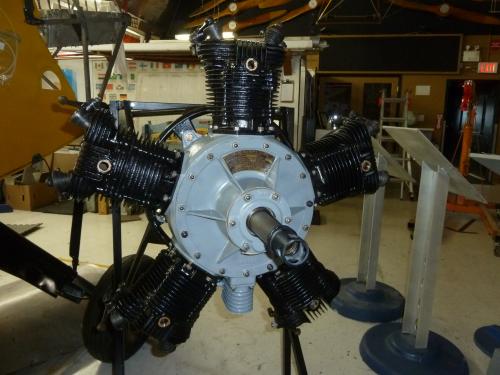-

Velie M5
The Mono-Aircraft Corporation (Don Luscombe), which had bought several Aircat engines, was dissatisfied with its reliability and availability. Mono-Aircraft Corporation persuaded Velie Motors Corporation of Moline, Illinois to essentially copy the Aircat. Velie received Approved Type Certificate No. 4 covering its M-5 engine on 22 Jun 1928. LeBlond, which then owned the rights to the…
-

Avro Canada Orenda
The Avro Canada TR-5 Orenda was the first production jet engine from Avro Canada’s Gas Turbine Division. The Orenda outperformed its rivals in most ways, and the Orenda-powered Canadair Sabres were among the fastest of all first-generation jet fighters. Over 4,000 Orendas of various marks were delivered during the 1950s, Avro’s greatest engine success. Development…
-

Wright R-3350 Turbo Compound
The Wright R-3350 Turbo Compound is an air-cooled, double-row, 18-cylinder, radial aircraft engine displacing 3,350 cubic inches. Turbo Compounds could produce up to 3,700 take-off horsepower when using the highest grade fuels available. Wright Aeronautical Division (WAD), a subsidiary of the Curtiss-Wright Corporation, produced many models of R-3350s between 1940 and 1960. However, the Turbo…
-

Wright R-1820
The R-1820 Cyclone 9 represented a further development of the Wright P-2 engine dating back to 1925. Featuring a greater displacement and a host of improvements, the R-1820 entered production in 1931. The engine remained in production well into the 1950s. The R-1820 was built under license by Lycoming, Pratt & Whitney Canada and also, during World War…
-
Wright R-1300
The Wright R-1300 Cyclone 7 is a 7-cylinder radial engine produced by Curtiss-Wright in the USA. It was developed from the larger twin-row Wright R-2600. Design work was started in 1942 but the first flight of an R-1300 did not take place until 1949. The engine was produced under license at Kaiser-Frazer and, later, at…
-

Rolls-Royce Nimbus
The Nimbus is a turboshaft engine comprising a gas generator section, which consists of a three-stage compressor, (two axial stages and one centrifugal stage), driven by a two-stage turbine in conjunction with an annular combustion chamber, and a power output section consisting of a single-stage free turbine driving an output shaft via a two-stage reduction…
-

Rolls-Royce Merlin
Rolls-Royce Merlin The Rolls-Royce Merlin is a British-designed V-12 piston aero engine with a liquid cooling system. It was designed by Rolls-Royce as a private venture using experience from their previous Kestrel and Schneider Trophy engines. The engine was first run in 1933 and flew in a Hawker biplane fighter producing 740 hp. Several new aircraft…
-

Rolls-Royce Derwent 1
Frank Whittle’s W2B engine powered the first British jet-powered flight of the Gloster E28/39 in 1941. This engine was subsequently developed by Rolls-Royce into the Derwent and was the first jet engine to power a front line fighter, the Meteor. Drawings started in April 1943 and it passed its 100-hour test at 2,000 lb rating…
-

Rolls-Royce Dart 506
This is one of the most successful early turboprop engines and was built by Rolls-Royce in the UK. In 1943 Rolls-Royce experimented with a turbine engine driving a propeller. This led to test flights of a RB53 (later named Dart) in a Lancaster bomber in 1947. To reduce weight the reduction gearbox was redesigned and…
-
Ranger L-440
The L-440 air-cooled, six-cylinder, inverted, in-line engine was manufactured in the USA by the Ranger Aircraft Engine Division of Fairchild Engine and Airplane Corp. The design dates from the early 1930s. The Ranger 6 evolved from the Cirrus air-cooled, in-line engine designed in 1928. Considerable research went into the design of the close-fitting baffles around…
-

PZL AI-14RA
The first production Ivchenko AI-14 was qualified in 1947. This Russian engine is one of the few radial engine still in production. Thousands have been built both for fixed wing and helicopter applications. The engine has been developed over the years beginning life at 260 hp (194 kW) before reaching 400 hp (298 kW) in…
-
Pratt & Whitney R-2800
The design of the R-2800 engine started in March 1937 following on from the successful smaller Wasp engine, with the first test flight in July 1939. There were many engineering challenges to develop this twin-row engine—vibration between the front and rear row of cylinders required a complex vibration damper system. Manufacture started in 1939 by…
